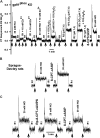Involvement of NADPH-dependent and cAMP-PKA sensitive H+ channels in the chorda tympani nerve responses to strong acids
- PMID: 21339339
- PMCID: PMC3073535
- DOI: 10.1093/chemse/bjq148
Involvement of NADPH-dependent and cAMP-PKA sensitive H+ channels in the chorda tympani nerve responses to strong acids
Abstract
To investigate if chorda tympani (CT) taste nerve responses to strong (HCl) and weak (CO(2) and acetic acid) acidic stimuli are dependent upon NADPH oxidase-linked and cAMP-sensitive proton conductances in taste cell membranes, CT responses were monitored in rats, wild-type (WT) mice, and gp91(phox) knockout (KO) mice in the absence and presence of blockers (Zn(2+) and diethyl pyrocarbonate [DEPC]) or activators (8-(4-chlorophenylthio)-cAMP; 8-CPT-cAMP) of proton channels and activators of the NADPH oxidase enzyme (phorbol 12-myristate 13-acetate [PMA], H(2)O(2), and nitrazepam). Zn(2+) and DEPC inhibited and 8-CPT-cAMP, PMA, H(2)O(2), and nitrazepam enhanced the tonic CT responses to HCl without altering responses to CO(2) and acetic acid. In KO mice, the tonic HCl CT response was reduced by 64% relative to WT mice. The residual CT response was insensitive to H(2)O(2) but was blocked by Zn(2+). Its magnitude was further enhanced by 8-CPT-cAMP treatment, and the enhancement was blocked by 8-CPT-adenosine-3'-5'-cyclic monophospho-rothioate, a protein kinase A (PKA) inhibitor. Under voltage-clamp conditions, before cAMP treatment, rat tonic HCl CT responses demonstrated voltage-dependence only at ±90 mV, suggesting the presence of H(+) channels with voltage-dependent conductances. After cAMP treatment, the tonic HCl CT response had a quasi-linear dependence on voltage, suggesting that the cAMP-dependent part of the HCl CT response has a quasi-linear voltage dependence between +60 and -60 mV, only becoming sigmoidal when approaching +90 and -90 mV. The results suggest that CT responses to HCl involve 2 proton entry pathways, an NADPH oxidase-dependent proton channel, and a cAMP-PKA sensitive proton channel.
Figures








References
-
- Abaffy T, Trubey KR, Chaudhari N. Adenylate cyclase expression and modulation of cAMP in rat taste cells. Am J Physiol Cell Physiol. 2003;284:C1420–C1429. - PubMed
-
- Botelho LHP, Rothermel JD, Coombs RV, Jastorff B. Cyclic AMP analog antagonists of cAMP action. Methods Enzymol. 1988;159:159–172. - PubMed
Publication types
MeSH terms
Substances
Grants and funding
LinkOut - more resources
Full Text Sources
Research Materials

